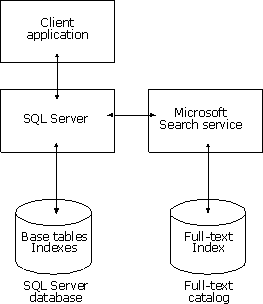Microsoft Search Service
The Microsoft Search service is a full-text indexing and search engine.
The SQL-92 standard defines only basic character-search capabilities:
- For a character value equal to, less than, or greater than a character constant.
- For a character value containing a string pattern.
Using the Microsoft Search service allows Microsoft® SQL Server™ 2000 and SQL Server version 7.0 to support more sophisticated searches on character string columns.
The Microsoft Search service has two roles:
- Indexing support
Implements the full-text catalogs and indexes defined for a database. Accepts definitions of full-text catalogs, and the tables and columns comprising the indexes in each catalog. Implements requests to populate the full-text indexes.
- Querying support
Processes full-text search queries. Determines which entries in the index meet the full-text selection criteria. For each entry that meets the selection criteria, it returns the identity of the row plus a ranking value to the SQL Server service, where this information is used to construct the query result set. The types of queries supported include searching for:
- Words or phrases.
- Words in close proximity to each other.
- Inflectional forms of verbs and nouns.
- Words or phrases.
The full-text engine runs as a service named Microsoft Search on Microsoft Windows NT® or Microsoft Windows® 2000. It is installed when the Full-Text Search feature is selected during custom installation. The Microsoft Search service itself is not installed on Microsoft Windows 95 or Microsoft Windows 98, although Windows 95 and Windows 98 clients can make use of the service when connected to a SQL Server installation running on Windows NT or Windows 2000.
The Microsoft Search service runs in the context of the local system account. During setup, SQL Server adds itself as an administrator of the Microsoft Search service. To ensure this relationship is maintained correctly, all changes to the SQL Server service account information must be made using the Properties tab of the SQL Server Properties dialog box in SQL Server Enterprise Manager.
The full-text catalogs and indexes are not stored in a SQL Server database. They are stored in separate files managed by the Microsoft Search service. The full-text catalog files are accessible only to the Microsoft Search service and the Windows NT or Windows 2000 system administrator.
